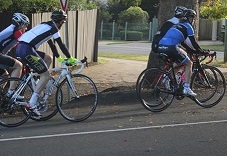 Cardio Respiratory Performance - Home Study Course
Cardio Respiratory Performance - Home Study Course
- comprehensive cardiorespiratory topics covered
- learn more about human health
- learn more about the anatomy and physiology of the blood, heart and lungs
- which factors affect heart health
- healthy lungs - efficient breathing and gas exchange
- essential for those working health care, health science, fitness, education
" ...it is very informative and worthwhile. I am glad I started the course. Of the many available from different schools, this offers the best value for money. "
- Sonia, studying Human Biology
The information given was excellent, but the assignments also made you look further to find answers yourself and I find this a much better way of learning than just being handed all the answers. It has given me a grounding knowledge in human biology which is perfect as I am applying to study Chiropractics at university next year. I couldn’t have asked for more from my tutor. She was very thorough and extremely helpful with any problems I encountered.
- Kate, Anatomy
COURSE STRUCTURE
There are 7 lessons as follows:
- The Science of Blood
- Blood Pressure
- Pulmonary Ventilation
- Gas Exchange and Transport
- Blood Flow & Gas Transport
- Cardio Respiratory Control
- Cardio Respiratory Disease
Each lesson culminates in an assignment which is submitted to the school, marked by the school's tutors and returned to you with any relevant suggestions, comments, and if necessary, extra reading.
SUMMARY OF COMPETENCIES DEVELOPED
On successful completion of the course you should be able to do the following:
- Explain the how blood affects human health, including its nature, how it works and its significance.
- Explain blood pressure and its relationship to health and fitness.
- Explain the physiology of pulmonary ventilation.
- Explain the physiology of gas exchange and transport.
- Explain relationship between blood flow and gas transport in the body.
- Explain the physiology of cardio-respiratory control.
- Explain the physiology of cardio-respiratory disease.
WHAT THE COURSE COVERS
Here are just some of the things you will be doing:
- Describe the composition of blood by discussing:
- Plasma
- Water
- Solutes
- Different proteins
- Wastes
- Nutrients
- Gases
- Electrolytes
- Platelets
- Leucocytes
- Erythrocytes
- Regulatory substances
- Explain the functions of blood, including transportation, regulation and protection, including examples of the roles played by some of the different blood components in the performance of these functions.
- List fifteen different substances which are transported by blood.
- Explain the movement of blood through the human body, including:
- where it moves
- how it moves
- Explain the physiology of three different blood disorders.
- List physical changes which occur in different parts of the body when the heart beats.
- Calculate cardiac output in two different specified situations.
- List factors which can affect blood pressure.
- Explain how blood pressure can be measured, using a gauge and inflatable sleeve.
- Distinguish between systolic and disystolic pressure, in a specific case study.
- Explain how pulse rate and blood pressure indicate different aspects of a subjects condition.
- Label the parts of an electrocardiograph, including:
- the p wave
- the QRS complex
- the S-T segment
- the T wave
- Describe in one paragraph each, the phases of the cardiac cycle, including:
- Relaxation period
- Ventricular filling
- Ventricular contraction
- Analyse two electrocardiographs for two different people.
- Draw electrocardiographs to illustrate five different types of heart malfunction, including:
- S.A. Block
- A.V. Block
- Sinus Arrhythmia
- Ventricular fibrillation
- S.T. Depression
- Compare ventilation during rest, exercise and recovery, for a specific case study.
- Explain lung capacity, for two people of similar demographics except one being a smoker and the other a non smoker.
- Explain lung function; including gas movements, and related muscle and bone movements.
- Explain intra pulmonary and interpleural pressure changes during breathing.
- Develop a chart which compares symptoms of breathing disorders, with scientific explanations of different problems.
- Explain the relevance of partial pressure gradients to gas exchange in the body.
- List factors affecting gas exchange in the human body.
- Explain how diffusion capacity is related to exercise.
- Explain one pathway where carbon absorbed as carbon dioxide is transported through the body.
- List factors which may limit effective blood flow and gas transport.
- Explain the way in which stroke volume can indicate a persons state of health.
- Explain how blood flow is redistributed through the body, during exercise.
- List factors which can stimulate cardio respiratory activity.
- Describe factors listed which can stimulate cardio respiratory activity.
- Explain characteristics of cardio respiratory control during rest.
- Explain characteristics of cardio respiratory control during exercise.
- Explain the physiological effects of three different coronary risk factors.
- Explain the anatomical changes to the body caused by atherosclerosis.
- Describe body changes that may occur (anatomical and physiological) during:
- Develop a checklist of indicators of different cardio respiratory complaints.
- Develop guidelines to minimise the risk of heart disease, in an specified person.
WHAT NEXT?
Register to Study - Go to “It’s Easy to Enrol” box at the top of the page and you can enrol now.
or
Get Advice – Email us at info@acsedu.co.uk OR
Use our FREE COUNSELLING SERVICE to contact a tutor
CLICK TO CONTACT US